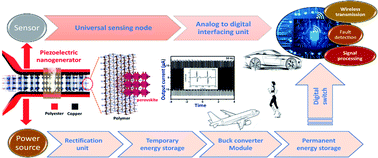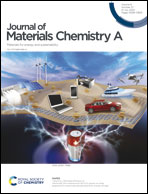Maximizing piezoelectricity by self-assembled highly porous perovskite–polymer composite films to enable the internet of things†
Abstract
There is an urgent demand in the industry for the development of compact, flexible, and sustainable power sources for self-powered internet of things (IoT) micro/nano devices. One of the most promising routes is to harness environmental energy through piezoelectric nanogenerators (PNGs). A novel, self-assembled, highly porous perovskite/polymer (polyvinylidene fluoride (PVDF) in this case) composite film was developed for fabricating high-performance piezoelectric nanogenerators (PNGs). The macroscopic porous structure can significantly enlarge the bulk strain of the piezoelectric composite film, which leads to a ≈5-fold enhancement in the strain-induced piezo potential. In addition, the novel hybrid halide perovskites (HHP)–formamidinium lead bromine iodine (FAPbBr2I) material can improve the conductivity of the final composite film due to its enhanced permittivity, providing a ≈15-fold amplification of the output current. Using these highly-efficient perovskite/polymer PNGs (P-PNGs), a peak output power density of 10 μW cm−2 (across a resistance of 7 MΩ) was obtained to run a self-powered integrated wireless electronic node (SIWEN). The P-PNG application was then extended to real-life scenarios including wireless data communication between the nanogenerators and personal electronics, efficient energy harvesting from automobile vibrations and also from biomechanical motion. This P-PNG based on a low-temperature full-solution synthesis approach, may initiate a paradigm shift by opening the realms of flexible PNGs as sustainable power sources.



 Please wait while we load your content...
Please wait while we load your content...